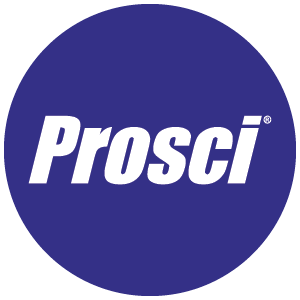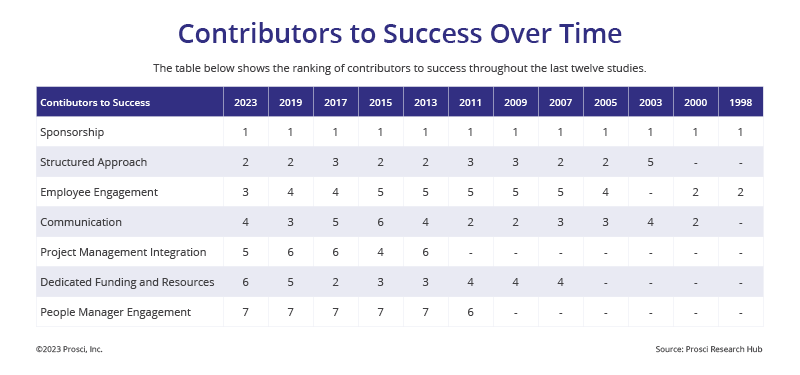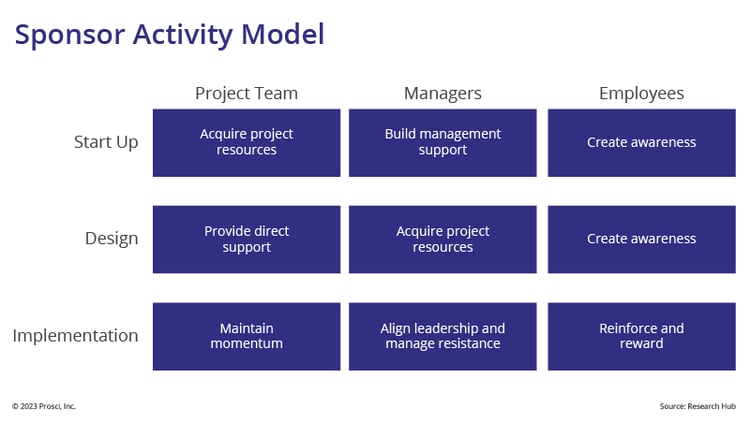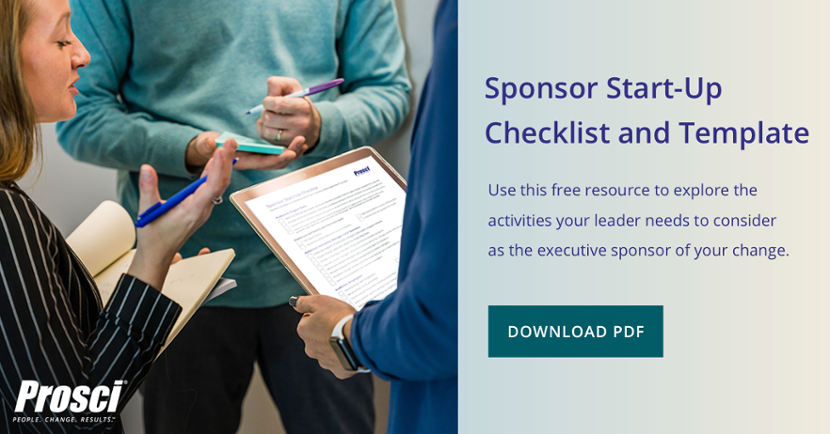5 Tactics for Engaging Effective Sponsors

6 Mins
Updated: August 31, 2024
Published: February 14, 2018

As a change management practitioner, you play an important role in preparing, equipping and supporting executives for their roles during change. When done effectively, sponsors become vital partners in achieving successful outcomes.
Failing to engage sponsors stifles change. Prosci's Best Practices in Change Management research study consistently shows that initiatives with sponsors who don’t adequately understand their roles correlate with much lower levels of successful outcomes.

Prosci recently researched the topic of executive engagement and it's correlation with change success. We asked both executives and change practitioners to share what attributes, skills and activities they believe are required to engage with sponsors effectively. By understanding both the perspectives of change practitioners and sponsors, we can begin to identify gaps in our approach to collaborating and seeking support.
These insights, paired with the research from the Best Practices in Change Management research, offer fresh perspectives and best practices for engaging executives and leaders in their sponsorship roles.
Most Effective Tactics for Creating
Active and Visible Sponsorship
During the webinar Bridging the Gap: Strengthening Executive Engagement in Change Initiatives, three Prosci leaders discuss the skills, attributes and strategies change professionals can cultivate to better align with executives’ expectations and priorities.
1. Provide the sponsor with ongoing support
When asked about the most important activities to effectively engage sponsors, respondents reported the following:
- Communicate regularly
- Build relationships
- Educate and train
- Define clear roles
- Listen actively
- Demonstrate value
- Involve early
- Align with strategy
- Be transparent
- Provide resources
However, these activities ebb and flow based on the phase of the project lifecycle. They are what we've called the SEAS (sponsor engagement activity streams) of Change.
Early on, risk is about identifying challenges, but then it evolves into addressing and mitigating those challenges. Communication evolves over the project's lifecycle based on when and where information distribution becomes more critical. You need to pay attention to these engagement activity streams but also give space to allow them to ebb and flow.
Insights on Preferred Support Across the Project Lifecycle

Preferred Support Themes

More tangible ways change managers can offer sponsors support are developing a sponsor roadmap or action plan, involving the sponsor in hands-on work to show visible support, drafting sponsor communications (e.g., newsletters, emails), preparing talking points, scheduling or inviting the sponsor to meetings and creating opportunities for the sponsor to be active and visible (e.g., town halls, roadshows, staff meetings and walk-arounds).
“It’s the power of we,” says Michelle Haggerty, Chief Operating Officer and Prosci U.S. President. “This isn't just one person's or team's work.”
2. Coach the sponsor on their role
The second most common tactic for creating active and visible sponsorship is to explain the role of effective sponsorship, establish expectations for the role and equip the primary sponsor with tools, advice and coaching to make their job as sponsor easy to fulfill.
“Executives are meant to live in a future state, thinking about what's next and how to continue to evolve to achieve the outcomes of the organization or the project,” says Haggerty, who often serves as a sponsor on Prosci’s change initiatives. “What I really need at times is to come back into the transition state, and I can't actually do that if I don't have a coach telling me where we are in the marathon.”
While it can be intimidating to coach upward, know what you offer and that it’s backed by data.
“As a practitioner, it's so common that we look at the executives and assume they know it all,” says Scott Anderson, Senior Principal, Global Research & Analytics at Prosci. “There's no way that an executive can have all the answers to every problem and challenge. They're relying on other people to provide them with the most important data to help them make the best possible decisions.
“We have a unique perspective that many executives may not be seeing,” Anderson adds. “And we know a lot of it because it’s research-based. We know if they implement XYZ, they will see improved outcomes in their ability to lead within the organization.”
Of course, this coaching relationship requires trust.
“Trust is very important because the work and conversations an executive has with their practitioner are about people,” Haggerty says. “If I don't fully trust the practitioner to keep the conversation between us and to really keep respect for the individuals that we're helping transform and change at the center of our conversations, that becomes really difficult. We're not going to have as effective change plans, because we're talking around the core issues.”
3. Hold regular meetings
Engaging with the sponsor through regular meetings or communications was the third most common tactic. Activities during these meetings or correspondences included: discussing project updates and progress, reiterating key messages, asking and answering questions, sharing successes and giving feedback on the sponsor’s involvement on the project.
During these meetings, use data-driven approaches to guide conversations.
“We use ADKAR Assessments at Prosci,” Haggerty says. “It shows where people are in the change journey, and that’s incredibly important and helpful data.”
ADKAR represents the five outcomes an individual needs to achieve for successful change: Awareness, Desire, Knowledge, Ability and Reinforcement. With this data, a practitioner can show where barriers exist, whether on awareness, knowledge, etc., and work with the sponsor to devise plans to remove those barriers.
Regularly meeting and sharing data helps create a bidirectional relationship, in which both parties understand the priorities and can challenge each other if needed.
4. Ensure the sponsor communicates directly with employees directly
Research participants indicated that ensuring that the sponsor communicates directly with employees (e.g., through face-to-face communications, live or recorded speeches, videos, written communication, etc.) is another tactic for having the sponsor actively and visibly engage in the change. This includes communicating the need for change across all levels of the organization and having personal discussions about the change with impacted employees.
5. Hold the sponsor accountable in their role
Study participants indicated that holding primary sponsors accountable and ensuring that they show support for the change management efforts were tactics for creating active and visible sponsorship. Suggestions included alignment to their personal interests, Key Performance Indicators (KPIs) or personal initiatives.
When formally evaluating the effectiveness of a sponsor, research participants used three methods:
- Clearly outlined objectives
- Observation and feedback
- Use of formal tools or methodologies
Sponsor Activity Model
Participants also described the most important types of activities a change sponsor can perform. The data was broken into three major project phases: start-up (planning), design and implementation. The activities and steps were further categorized by the primary target audiences:
- Project team
- Managers (including business leaders)
- Employees (or front-line stakeholders)
Prosci's Sponsor Activity Model illustrates the responsibilities sponsors undertake during each project phase (start-up, design and implementation). The activities required for each box in this figure are intended to be general descriptions for the category.
 For each unique change project, change management teams should collaborate with sponsors to outline and agree on the specific sponsorship activities sponsors should perform with each audience at each phase of the project. This checklist provides a simple framework for getting started. More extensive lists of specific activities in each of the model's nodes are available in Prosci’s Best Practices in Change Management report in Research Hub.
For each unique change project, change management teams should collaborate with sponsors to outline and agree on the specific sponsorship activities sponsors should perform with each audience at each phase of the project. This checklist provides a simple framework for getting started. More extensive lists of specific activities in each of the model's nodes are available in Prosci’s Best Practices in Change Management report in Research Hub.
When it comes to implementing the Sponsor Activity Model, the change management team can enable the successful outcome of each activity by acting in a role similar to an executive assistant, scheduling events, preparing for the events and making sure the sponsor is fully prepared.
Gaining Sponsor Access
Change sponsors are busy people, but their role in the change process is invaluable. If you struggle to get time on your sponsor’s calendar, try the following tips:
Attend existing meetings
Start regularly attending meetings that are already on the executive’s calendar. Request time on the agenda to give a status update. After the meeting, send the sponsor a follow-up chat or email.
“You can tell them what you noticed in the meeting and reinforce what’s going on from a change perspective,” Haggerty says. “If you’re not getting a standalone meeting with them, anywhere you can plant seeds will garner attention. Typically, they’ll start to notice. That tactic of joining existing meetings tends to serve as an entry point into more consistent touchpoints with the sponsor.”
Focus on what you can control
If you can’t get time with your sponsor, see if you can get time with someone in their inner circle, like another executive or their assistant.
“Thinking back to an executive whose schedule I had a hard time getting on, I focused on what I could control,” Anderson says. “What I could control is that I was able to meet with other senior-level executives who I knew could have indirect influence on the sponsor. It was an issue of me identifying what scope I could control and then operating within that framework.”
Use your time
Never skip an opportunity to meet with your sponsor. If they have the same hour block open every week, take it.
“Once you've got that time, don't let go of it,” Anderson says. “Build it in as a recurring thing, and then make sure you provide value during that time. Make it as easy as possible for them to fulfill their role.”
Learn More About Sponsorship
The resounding theme from more than two decades of change management research is that executives and leaders play a pivotal role in change. This article on a sponsor's importance and role will help you discover more about the role of a sponsor and how you can support your sponsor and create a sponsorship plan. You can also use this Sponsor Start-Up Checklist to start planning sponsor activites.


